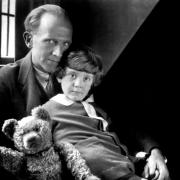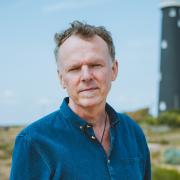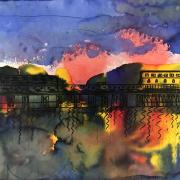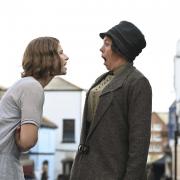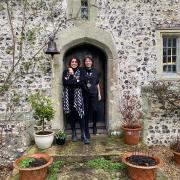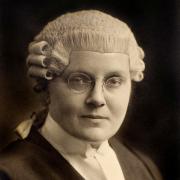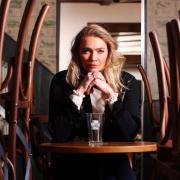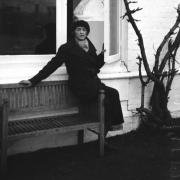Horsham fine artist Benjamin Smith draws on skills and techniques once abandoned by mainstream art schools. Duncan Hall finds out more

Walking into Benjamin Smith’s recent exhibition at Horsham Museum one would have been forgiven for thinking he was a photographer.
Images of classical busts and statues lined the walls captured in an almost cinematic monochrome style – the whites contrasting strongly against almost glossy blacks. And elsewhere beautiful black and grey portraits looked like they’d come out of a photographic studio. It was only by looking closely that one could see the portraits were actually beautifully rendered pencil drawings.
The title of Benjamin’s exhibition, Silence and Slow Time, refers to the effort and sheer hard graft which have gone into these works. It was part of the advice given to him by his grandfather Robert Ball, an engraver, painter and draftsman in his own right, penned on the back of a postcard of one of his works which Benjamin still treasures today: “Get a similar object,” the advice goes. “Don’t speak and give it 100 per cent of your concentration.” In the same postcard Robert – the former principal at Stroud Art College who died in 2008 – was scathing about the modern art world. “To do modern art you must never stop talking, this helps to stifle any logical thought or criticism.”
It can take Benjamin a month to create a charcoal drawing of the plaster casts old masters used to teach their apprentices the effect of light and shade on three dimensional forms. His pencil portraits, which he will focus on from this September after receiving a prestigious QEST Siegmund Warburg Scholarship last year, take up to two weeks and are drawn from life.

They both follow the tenets of the fine art education the former commercial lawyer has embarked upon after giving up his day job two years ago to become a full-time artist. “Life as a lawyer doesn’t leave a lot of time for leisure,” admits Benjamin, 38, from his Queensway home in Horsham, which also houses his studio. “I had reached a point where I felt like I had pushed it as far as I could and had to take drastic action.” Having practised in Birmingham for 12 years, Stroud-born Benjamin and his partner Richard Walker moved to Horsham two years ago – close to Gatwick for Richard, who is a captain for Easyjet, and easy for Benjamin to get to the London Atelier of Representational Art (LARA) in Vauxhall.
As part of his realist training Benjamin studies anatomy, as the old masters would have done. “It’s about starting from the inside and building,” says Benjamin, who has produced écorché drawings of flayed figures as practised during the Renaissance. “Most of the best anatomy books go back to the 19th century.” The studies of form and realist techniques are out of fashion, with even Benjamin’s grandfather struggling to find mentors to help him. “With artists in the mainstream there is a degree to which they are a little ashamed at their lack of formal training,” says Benjamin. “A lot of artists like to give the impression they emerged into the world fully formed with no further development necessary! A lot of what makes art fascinating is its incredibly rich history which is all there to be drawn upon and absorbed.” Although Benjamin’s work is based on older techniques and subjects such as mythical characters, he believes the 20th and 21st century slant he is able to put on it makes it unique. “It’s the rise and fall and rise again of realist painting and drawing,” he says. “Following World War I a lot of art schools departed from that way of studying and things like abstraction came to their zenith. My grandfather was a fish out of water.” Robert received early training because of Birmingham businesses’ desire for skilled draftsmen, until his teachers encouraged him to go to the Royal College of Art. Although the training Robert received became increasingly marginalised, it was taken up by US artists, two of whom set up a Florentine art school in the 1960s, and whose descendants are behind LARA.
Benjamin now believes there is a renewed desire for those old techniques to be taught in the rise of ever-more realistic computer games and CGI animation. “There’s a whole new generation of artists who desperately need to learn the skills,” he says. “With my exhibition I wanted to show the narrative that takes draftsmanship from the Renaissance through to the 19th century and into the world of CGI and computer animation which relates to my development as an artist. I am always studying.”
He has become involved in Horsham’s art scene, taking part in the annual June Artists’ Trail, and displaying his work with the Association of Sussex Artists, which helped him get his exhibition at Horsham Museum.
He is now looking to return to oil painting ahead of his year studying portraiture. And he is enjoying exploring the countryside around his Sussex home. “I was worried when I moved to Sussex that Brighton might be the black hole which sucked in all the artists,” he says. “But this is a fantastic part of the country which I have started to explore – not just for ideas, but also the artists and creative individuals who live around here.”
For more information visit www.benjaminsmithfineart.com
And for a collection of Benjamin’s grandfather Robert Ball’s work visit www.robertballart.com




